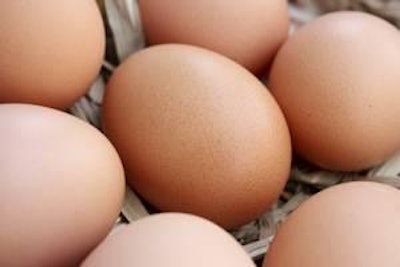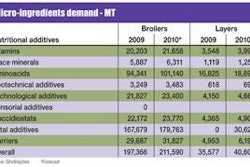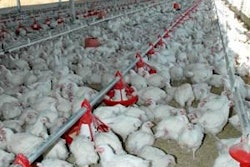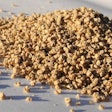
Providing food that is both natural and convenient is still a key success factor.
Maro Ibarburu, program manager for the Egg Industry Center (EIC) located at Iowa State University released the June-July Statistical Report on August 4.
The current report is summarized for readers of Egg Industry.
- The U.S. estimated cost of production for June 2010 was 58.4 cents per dozen ex-farm, 1.4 cents per dozen more than the previous month. The seven-month average production cost for 2010 attained 57.9 cents per dozen, 1.5 cents per dozen (2.5%) less than the 59.4 cents per dozen recorded during the first seven months of 2009.
- The July ex-farm egg price estimated by the USDA-NASS was 52.8 cents per dozen, compared to 42.2 cents per dozen for June 2010 and a seven-month average of 67.6 cents per dozen for 2010 to date.
- The margin represented by “income minus cost” for July was -5.6 cents per dozen continuing the negative trend from June of -14.8 cents per dozen. For the first seven months of 2010 the average margin was 9.7 cents per dozen. The negative July 2010 margin was equal to the value in July 2009 reflecting the annual seasonal trend.
- In evaluating the low margin for July, it was noted that feed cost was 35.1 cents per dozen, with pullet depreciation at 8.5 cents per dozen and other fixed and variable costs of 14.7 cents per dozen, applying the standard cost factors used by the EIC. These values remained virtually unchanged through the first seven months of 2010. Contribution per hen, based on July figures remained negative at -10.7 cents per bird which was an improvement over the -27.3 cents per bird value in June. The cumulative seven-month hen contribution now stands at 126.6 cents per bird.
- The Urner Barry (UB) simple average price for six U.S. regions, assuming 80% large eggs, was 51.4 cents per dozen for July compared to 44.3 cents per dozen in June 2010. The seven-month simple average UB price was 66.7 cents per dozen.
- In reviewing retail prices for table eggs, the Bureau of Labor Statistics and the Department of Commerce estimated a June average of 149.4 cents per dozen, 1.9% lower than the May 2010 value of 152.3 cents per dozen but almost equivalent to the 152.9 cents per dozen recorded in June 2009. The simple average retail egg price for the first five months of 2010 was 171.3 cents per dozen.
- The large to medium grade white egg price spread over six regions was 22.1 cents in July compared to 17.0 cents per dozen in June with an average of 18.2 cents per dozen for the first seven months of 2010. Regional spreads ranged from 19.4 cents per dozen in the Northeast to 25.3 cents per dozen in the South Central region.
- During July 2010, layer feed averaged $205.40 per ton, which is 2.0% higher than the seven-month average of $201.40 per ton based on six regions. During June the price range among regions was $180.80 per ton in the Midwest rising to $223.00 per ton in California. The differential of $42.20 is equivalent to approximately 9.00 cents per dozen applying realistic industry production parameters
- For the first seven months of 2010, commercial-pullet strain eggs in incubators has remained almost constant at 39.76 million with a range of 37.5 million in July to 42.9 million in April. The corresponding 2009 value for the first seven months was 37.194 million
- Straight run hatch for June attained 42.6 million with an average for the first six months of 42.9 million.
- Projections for pullets to be housed in future months based on the five months-previous hatch and incorporating a 5% mortality factor, include a range in the increase in placements from 15.75 million pullets in April to 21.44 million pullets in September 2010. The 11-month average of 18.31 million pullets per month for 2010 is 5.6% greater (1.0 million pullets) than the 11-month average of 17.34 million per month for 2009. The 2005 to 2009 monthly average was 16.8 million pullets placed each month.
- For July 2010, the USDA-NASS estimated the national flock at 280.5 million hens, which is 1.0 million more than in June 2010, following historical trends. Applying the University of California model based on USDA-NASS data for chickens and eggs, it is estimated that the November 2010 flock will attain 220.0 million hens aged less than 72 weeks.
- This incorporates the assumption of 9% mortality from 20 through 72 weeks of age. As at the end of June 2010, 23.8% of the national flock was over 72 weeks of age. With the exception of March 2010, which was an aberration, the seasonal pattern of a decline in molted flocks from January through April appears to be holding. For the entire year of 2009, an average of 24.7% of the national flock had been molted compared to 31.7% in 2008.
- Six regions reported a simple average of 24.6% molted hens in July 2010 reflecting all states surveyed by the USDA-NASS. The actual proportion of molted hens in the U.S. varies widely, from 9.5% in the Northeast to 37.0% in California. The seven-month average of 23.6% molted hens in the U.S. flock and differences among regions reflect production costs, revenue for eggs and realization value for spent hens.
- The most recent estimate of the national table-egg flock for August 2010 is 281.1 million hens. This number is expected to increase steadily to 291.9 million in December. Given current projections of prices which are functions of supply and demand, flock sizes could be trimmed by depletion or increased by retention or molting subject to available capacity including re-caging. Prolonged depression in price beyond current estimates will inevitably result in a decrease in hen numbers since flocks will be depleted at a rate faster than projected.
- Don Bell projects an Urner-Barry large Midwest price of 96.1 cents/dozen for August with prices in November and December attaining approximately 120.0 cents per dozen. The post-January drop will occur in 2011 with April and May forecast to be 94.1 and 83.0 cents per dozen respectively. The future prices forecast in July have been adjusted by approximately 10 cents per dozen in comparison to projections published in June.
- The top six egg-producing states with 159.02 million hens represent 57.7% of the total national flock. In descending order these states are Iowa (19.4% of total), Ohio (9.8%), Indiana (8.3%), Pennsylvania (8.2%), California (7.0%), and Texas (4.9%). States reporting to the USDA-NASS represent 99.1% of all hens producing table eggs.
- Rate of lay for the first six months of 2010 attained 76.0%. This is higher than in 2009 during which an average of 75.3% was recorded. The positive difference of 0.7% in production level is equivalent to a daily volume approaching 5,500 cases. Average rate of lay is a function of weighted flock age and is influenced by climate.
- During June 2010, 6.206 million cases of eggs were broken under Federal inspection, which is 8.7% more than in May and 4.1% more than in May 2009. For the first six months of 2010, egg breaking was up by 1.9% over the corresponding period in 2009. For the year to date, 31.1% of the 107.419 million cases produced have been broken compared to 30.8% for the entire year of 2009. It is noted that the proportion of eggs broken has steadily declined from the 2005 high of 35.1% to a projected value of 30% for 2010.
- The revised egg consumption value for 2010 is projected to be 247.1 per capita, almost 0.3%, lower than the 247.7 eggs per capita recorded in 2009. Over the past seven years the highest per capita consumption of 257.8 eggs was recorded in 2006.
- According to the USDA Foreign Agricultural Service, 847,000 cases of shell eggs were exported during the first five months of 2010 with Hong Kong (38% of export volume), Canada (12%) and China (6%) representing the most significant importers. Shipments of shell eggs for the first five months of 2010 represented 0.9% of U.S. production.
- Exports of egg products as shell equivalents represented 1,876,000 cases for the first five months of 2010, equivalent to an average of 2.09% of U.S. production.
- Combining shell eggs and egg products, total exports during the first five months of 2010 represented the equivalent of 2.72 million cases or 3.04% of U.S. production.





